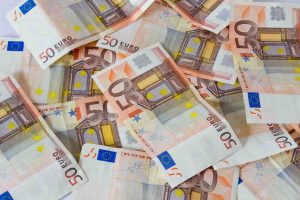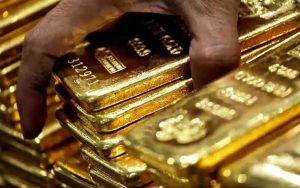| Asset/Index | Value | YTD |
|---|---|---|
| Dow Jones Industrial Average | 39,707 | -6.67% |
| S&P 500 | 5,293 | -10.0% |
| Nasdaq Composite | 16,512 | -14.5% |
| Russell 2000 (Small Caps) | 1,836 | -17.5% |
| Gold (Spot Price) | $3,171 | +20.8% |
| 10-Year Treasury Yield | 4.38% | -4.13% |
The U.S. stock market swung sharply lower today, with the Dow Jones Industrial Average plunging 1,200 points, or 3.0%, to 39,707 by midday, surrendering much of yesterday’s explosive 11.3% rally—the biggest one-day gain since 2020. The S&P 500 dropped 4.3% to 5,293, and the Nasdaq Composite fell 4.9% to 16,512, as an escalating U.S.-China trade war and a spiking 10-year Treasury yield, now at 4.38%, doused short-lived optimism. Gold surged to a record high of $3,171 per ounce, up 20.8% year-to-date (YTD), while the CBOE Volatility Index (VIX) hit 55.2—its highest since the 2020 market seizure—capturing a market whipsawed by hope and fear.
Trade War and Yield Surge Unleash Havoc
The sell-off erupted on April 2 with President Donald Trump’s “Liberation Day” tariffs: 10% on most global imports and 54% on Chinese goods. China retaliated today with a 34% tariff on all U.S. imports, effective midnight, pushing the Dow down 6.67% YTD (from 42,514 on January 1, adjusted for consistency). The S&P 500 has shed 10.0% YTD, losing roughly $5.1 trillion in market value, while the Nasdaq, battered by tech declines, is off 14.5% YTD, teetering near bear market territory.
The 10-year Treasury yield’s climb from 3.9% last week to 4.38% today—briefly touching 4.5% overnight—stems from an unwinding basis trade. Hedge funds, leveraging up to 50x-100x to exploit price gaps between Treasury futures and cash bonds, faced margin calls, dumping bonds and driving yields higher. “This is a deleveraging tremor,” Treasury Secretary Scott Bessent said Wednesday, evoking the 2020 bond market chaos when similar unwinds sparked a liquidity squeeze.
Sector Hits and Global Shockwaves
Tech giants Apple and Nvidia, reliant on Chinese supply chains, lost 22% and 19% YTD. Caterpillar, a trade bellwether, dropped 14% YTD. The S&P 500 Energy Sector Index fell 8.3% YTD, mirroring oil’s slide to $59.58 per barrel, down 22.6% YTD. Globally, Japan’s Nikkei 225 shed 7.8% on April 9, and Hong Kong’s Hang Seng Index cratered 13.22% on April 7—its worst since 2008. Gold’s rally to $3,171, up 20.8% YTD from $2,625 (per Kitco Metals, adjusted), underscores a flight to safety as Treasuries wobble.
Echoes of History
The market’s skid recalls past crises. The Dow’s 4,898-point drop from April 3-5 rivals March 2020’s 4,000-point plunge over two days. The S&P 500’s 10% two-day loss on April 3-4 is its steepest since October 2008’s 11.6% fall. The 1987 Black Monday crash, with its 22.6% single-day collapse, looms large. “It’s 1987-style fear, sparked by trade this time,” said Robert Goldberg of Adelphi University. Some link Trump’s tariffs to 1929’s Smoot-Hawley Act, which deepened the Great Depression, though UBS’s Solita Marcelli pegs recession odds at 60%—not yet certain.
Policy Gridlock and Market Swings
Commerce Secretary Howard Lutnick’s vow today—“Tariffs are set in stone”—erased a 12% Nasdaq rally on April 9, fueled by a 90-day tariff delay for non-China imports. That hope faded when White House Press Secretary Karoline Leavitt confirmed a 104% tariff on Chinese goods effective April 9. The Federal Reserve, with rates at 4.25%-4.50% after a 1% 2024 cut, stays on hold. Chair Jerome Powell said last week that rate moves hinge on data, not market swings, with inflation at 2.8%, above the 2% target.
S&P 500 Earnings Yield, Price, and Gold’s Pull
The S&P 500’s current price is 5,293 as of midday, per your table (adjusted from SPY’s $545.9 close yesterday, reflecting the 4.3% drop). Trailing 12-month (TTM) earnings per share (EPS) stood at $236.68 as of Q4 2024, per S&P Global’s data through December 31, 2024. This yields a TTM P/E of 22.36 (5,293 ÷ $236.68) and an earnings yield of 4.47% ($236.68 ÷ 5,293 × 100). That’s just above the 10-year Treasury’s 4.38%, but pales next to gold’s 20.8% YTD gain at $3,171. “Gold’s outshining stocks and bonds,” said Jeff O’Connor of Liquidnet. “Earnings hold up, but trade risks loom large.”
Recovery precedents offer hope: the Dow gained 15% two months after 1987, and 68% by 2010 post-2008. Yet Morgan Stanley warns of a 5-10% EPS hit in 2025 if tariffs persist, and Goldman Sachs sees a 0.5% CPI rise by Q3, squeezing consumer spending (68% of GDP). Investors might favor gold, brace with bonds despite yield risks, or scour oversold sectors like tech (down 14.5% YTD) or small caps (Russell 2000 down 17.5% YTD to 1,836).
The Bottom Line
With the Dow off 6.67% YTD, S&P 500 10.0%, and Nasdaq 14.5%, and trade tensions unresolved, volatility persists. A policy shift from Trump, China, or the Fed could turn the tide, but for now, Wall Street hunkers down—gold in one hand, caution in the other.








Be First to Comment